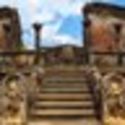-
About
- About Listly
- Community & Support
- Howto
- Chrome Extension
- Bookmarklet
- WordPress Plugin
- Listly Premium
- Privacy
- Terms
- DMCA Copyright
- © 2010-2025 Boomy Labs


 Lavinia Woolf
Lavinia Woolf
Listly by Lavinia Woolf
Dating back centuries, the art form of mask carving is a folk art item that has stood the test of time. From devil masks to that of the divine, here are the island's top six mask varieties.

Perhaps the most colourful and fearful looking of the traditional Sri Lankan masks the Raksha Marks or the Demon Masks as they are widely known are commonly featured in Raksha dance rituals and also used to ward off evil spirits in households. Most commonly employed in dance performances in the Kolam Maduwa Raksha Masks include 24 individual masks used to represent various demons according to myth and local folklore. Sri Lanka was believed to have been occupied by members of the Raksha race in ancient times with King Ravana of Ramayana fame serving as the monarch. There are five main varieties of Raksha masks used in Kolam dance sessions today. They are the Naga Raksha Mask or Cobra Mask, the Gurulu Raksha Mask, Maru Raksha Mask (associated with Death), Purnaka Raksha Mask and the Rathnakuta Raksha Mask.

Often regarded as one of the more unique mask varieties in Sri Lankan folk art, the Garuda Mask has a rich history steeped in Hindu mythology and spirituality. As the vehicle of Lord Vishnu, the Solar Bird as it is known is employed in the Kolam tradition to ward off or battle with the cobra demon. Elaborate and frightening in appearance the Garuda Mask typically features defeated cobras which the sacred bird wears as trophies of past victories. The dance itself is considered therapeutic and cathartic as the dance performance is meant to dispel the health hazards posed by snake bites to villagers.

Used in conventional works of theatre, Kolam performances are in fact a variety of plays that are employed not only to entertain but also to re-enact various mythologies and folk beliefs of villagers. Kolam mask manufacturers are few and far between in this day and age although the Ariyapala Wijesuriya clan still produces masks and performs Kolam dance rituals to this day. The history of the Kolam masks dates back to the era of King Maha Sammatha. Legend states that his wife, the queen felt the urge to see a masked dance performance during pregnancy although such dance forms were unknown to the local populace during the period. The deities Sakra and Vishvakarma (the patron god of craftsmen) it is said are believed to have joined forces to create the masks and the songs and dance rituals known as Kolam today to entertain her majesty. Humorous in appearance and context Kolam mask varieties include popular folk characters the likes of Nonchi akka, Mudali, Panikkala, Lenchina, Hewa and Jasaya.
Primarily used to cure illness Sanni masks come in 18 varieties which each mask serving as the representative mask for various physical ailments ranging from small pox to fits and fevers. The cause of these ailments is thus attributed to a specific demon that is represented at the Sanni performance as a masked dancer. The patient is made to witness the dispelling of these disease causing demons or Sannis in the performance to alleviate not only the physical symptoms of the disease but also the physiological stronghold the illness has on the patient.

Usually used to symbolize those belonging to the Karava ethic group, the Makara Mask is the indicative mask for Sri Lanka's fishing communities. Carved on supple wood varieties such as Balsa wood the Makara Mask features a woman depicted as juggling spheres with her hands. A wire mechanism is used to move this element up and down when the wearer of the mask is in motion. Visitors based in a beachside boutique hotel Sri Lanka has to offer such as The River House can visit a mask workshop along the coastal belt to gain a better understanding of the folk art form.

As the chief mask of the Devil Dance, the Maha Kola Mask holds a special place in folk art and the Sanni tradition. Worn by the "medicine man" or the dancer who portrays the heroic figure who dispels the illness from the patient by destroying the demon possessing the body, the Maha Kola Mask wearer is a trusted figure in folk traditions entrusted with the curing of the patient by the family.
